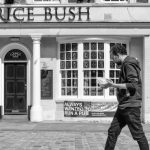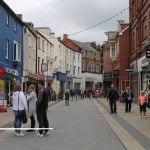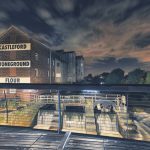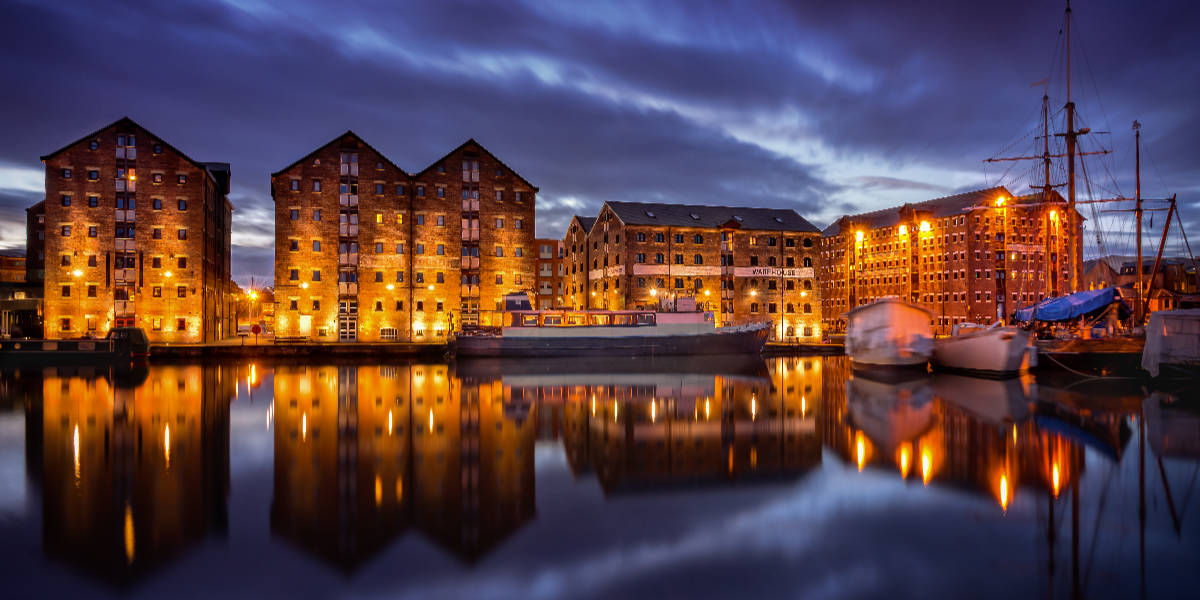
Could Gloucester be the place for your summer holiday or weekend staycation break? Let’s take a look…
As a cathedral city, we already know that Gloucester is important, but the fact is that historically it was so so highly regarded that they didn’t bother to put its population in the doomsday book as “everybody then knew about it.
The thing is it may be thousands of years old, but there are people who don’t know much about the place. So we thought it was high time we got around to seeing what this Gloucestershire location has to offer both from a visitor perspective or as a potential resident.
So join us as we tour through the history of Gloucester starting at the beginning which in this case means Roman times…
Early Gloucester
What was Gloucester like all the way back then? Well, it began life in Roman times when they built a town at the crossing point of the River Severn. It is thought that they originally built a fort to guard the river crossing against barbarians in AD 49. Twenty years later they built a second fort in the area, where Gloucester town centre is nowadays.
Before the first hundred years had passed, the Roman army had worked its way north in an ever-persistent attempt to take more territory. At this point. The town was renamed Glevum and given over to retired soldiers who had helped conquer the region and who wanted to settle with their families.
Legio II Augusta
When the Romans retreated from other towns in England, they left them abandoned. Not so with Gloucester, which had enough of a retired population to survive. It is thought that the Legio II Augusta was stationed here as they got ready to attack Wales. It went on to be an important town, the capital of the Britannia Secunda.
As a result of all this Roman attention, the town of Gloucester had piped water all the way back in Roman times. It had temples, bathhouses, and villas. Drainage and sewers, a forum, and colonnades. There was a main street, several shops, and a whole population. At its height, it is estimated that there were 10,000 people living in Glevum.
By the end of the 2nd century, there were so many people living in the area that they had to expand the city wall. As a result, the whole surrounding region is rich in Roman artefacts. Archaeological digs in and around Gloucester have led to a wealth of objects being unearthed, many now housed in the local museums.
The Romans retreated in the fourth century, leaving behind some roads and streets which still exist and a handful of Latin words that form the roots of the Welsh language. The people that stayed behind were the descendants of soldiers. They were those so intermarried with the local populace that Rome was no longer their home. This retreat left a mostly abandoned then town for the local tribes to fight over.
Post Roman Gloucester
In the following years, Gloucester was counted as part of Wessex. From the 6th century right up until the unification of England, the town was fought over by different claimants. It was supposedly part of Mercia, Hwicce, and then changed back into the hands of Wessex.
In 681 the Abbey of St Peter was opened by the King of Mercia. In the tenth century, it was then home to the remains of Saint Oswald. A shrine was built which brought tourism to the area. The town continued to grow, with enough of a population to open a mint, house multiple religious tourists, and even house Edward the Confessor’s court for a while in the middle of the 11th Century.
The Norman invasion in 1066 didn’t have as much of an impact on Gloucester as you might think. The new king made his friend Robert Fitzhamon the head of the area and as the said friend also ran Cardiff the next few decades saw the futures of both places intrinsically linked.
The population of the town was not recorded in the Domesday survey of 1086, which sometimes happened with larger established towns. However Gloucester is reported as having 1 mill and four fisheries, prized possessions in those days!
We’ll take a brief pause here to unearth a few bits of trivia before we go on with the medieval times.
Fun Trivia about Gloucester
We like to research the best fun things about a place when we review towns and Gloucester is no exception. Here are the Five Minutes Spare favourite fun facts about the town, for your amusement.
- This is a royal city. King Edward II is buried here, and King Henry III was crowned within its walls.
- There are several Roman ruins around the area you can visit. In the Eastgate – one of the true-to-form Roman streets – you can go underground to view some real Roman stuff.
- When the window of Gloucester Cathedral was installed around 1350, it was the greatest window in the entire world. At 22 metres by 12 metres, it was the same size as a tennis court!
- The American National Anthem was composed by a local man named John Stafford Smith. We can’t find any record of him ever visiting the United States Though.
- The Domesday Book didn’t make much mention of Gloucester because it assumed everyone would know where it was… The book itself was planned and executed from within the town’s very walls.
- Cheese was one of the biggest products of the area in Medieval times. In fact, the indoor market was built in 1498 for the sole purpose of housing all the cheese.
- Speaking of Cheese today Double & Single Gloucester are both popular types.
We are sure there are a bunch of other interesting facts but we are conscious your attention span is only so long, so let’s continue with middle age Gloucester.
Gloucester in the Middle Ages
The City has a few nasty fires in the middle ages, with significant outbreaks being recorded in 1122, 1190 & 1214. However, two quick succession ones in 1222 & 1223 led to the town council banning all thatched roofing long before other areas of England.
The town was given its first charter by Henry II in 1155, which gave those in charge the same control as those in charge of London; a high honour indeed. Later his grandson King Henry III was crowned here in 1216. He was only 10 years old at the time so had another ceremony a few years later.
For the next few hundred years, it became a centre of religious worship. Several abbeys and religious houses occupied the area, most of which would later be shut down by Henry VIII. They included Llanthony Secunda Priory, the Franciscan Greyfriars, the Dominican Blackfriars, the Cathedral itself, and a thriving Jewish community. However, the Jewish population suffered a mass expulsion in 1275 and most were forced to relocate to Bristol.
From 1378 until 1406 parliament was held in Gloucester beginning with Richard II and ending in the reign of Henry IV. The parliamentary rooms were within the Cathedral, which tells a lot about England at the time. Whatever else it was, Gloucester was a God-fearing place.
Industry-wise cheese, wool, leather and iron dominated, and overall the city thrived. The population was growing fast and the city was full of shops and amenities to cater for them.
Richard III Incorporates The City
King Richard III incorporated Gloucester in 1483 and another two charters were added before 1510. Abbey Church was granted Cathedral status in 1541 and its first Bishop installed.
This new found Catherdal status was slightly tarnished in 1555 when the cities Bishop John Hooper was burned at the stake for heresy on the orders of Mary Tudor (Bloody Mary). This made him one of the first of many protestant martyrs in Britain.
The first of many plague outbreaks struck a decade later and the city would suffer six significant outbreaks in the following years, with the last striking in 1637. Still, it was not all doom and gloom as Elizabeth I granted Gloucester port status in 1580.
The Civil War
The last of the plague outbreaks came and went just in time for the city to become a major player in the early stages of the first English Civil War. Gloucester was laid under siege for nearly a month beginning in August 1643 and ending in the September. Despite much bombardment, it stood firm against the Royalist forces and inflicted severe losses on the Royalist forces. Rumour has it that you can still see the occasional civil war era ghost roaming the streets late at night.
Gloucester did pay the price for choosing Parliament though, as when the Monarchy returned Charles II ordered the city walls to be destroyed in 1662.
In 1666 a second grammar school (Sir Thomas Rich’s) was opened and to this day it remains well respected. This boosted the cities status further and it is estimated the population of the city had reached around 5,000 by 1680; quite large for the area.
The City got an Infirmary in 1761 and the removal of the old gates made commuting easier. Gloucester was becoming a regional powerhouse and its status further increased when a prison was built in 1791.
Nineteenth-Century Gloucester
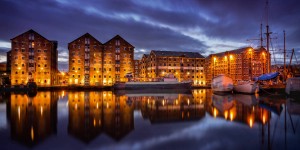
Image: Dave Knibbs/Shutterstock.com
The nineteenth century was a time of change. The local wool industry went into decline as cotton rose to prominence. Still, the city soon adapted and a new industry took over in the shape of Pins – for sewing. Yes, the humble pin became the big thing in the city as the industrial revolution rolled on. Iron has always been mined nearby but now it was turned into steel to support this newfound industry. Gloucester pins were incredibly popular and, in 1900, about a fifth of the population were employed in making them.
1820 saw gaslighting arrive and it stayed the main source of light until electric lighting arrived in the early 20th century. In 1831 a free dispensary opened which gave out much-needed medicine to the poor. The late 1800s also saw sewerage systems first laid by the Romans lengthened and improved.
In 1872 an art and science school opened, and trams began to run from late that century and a canal was built. During this time a dry dock was also added so that ships could be built and repaired through this port. 1827 saw the huge north warehouse erected and the Victoria dock was opened in 1849.
Trains first arrived in November 1840 connecting the city to Cheltenham and soon more stations and lines were added. This connected Gloucester to the fast-growing areas of Bristol & Swindon which boosted the towns next big industry…
Anyone Got A Match?
Match-making company, S. J. Moreland and Sons, set up in the outskirts of Gloucester in 1867, and for many years they produce the iconic “England’s Glory” matches. This was later taken over by Bryant and May wh ceased production in the 1980s. However this Iconic Gloucestershire match still exists today, all be it made in Sweden.
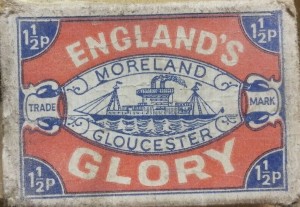
By the late 1800s, the local population had grown to around 47,000 – but sanitation and the water supply hadn’t kept up with this growth. This didn’t help with the population’s general health and as recently as 1895 a smallpox outbreak killed 434 people.
As the nineteenth century drew to a close pins waned in demand so railway car making became the next big thing in Gloucester. It soon became the cities most important industry, only for that to die out before the first world war.
In 1900 electricity arrived and by 1904 the once-popular horse-drawn trams were replaced by electric versions. In 1929 buses would replace trams. A fire station was built in the early 20th century, followed by slum clearance which led to the building of new housing estates. WWI was also hugely impactful in town. A whole regiment of young men left the town and many of them didn’t come home again.
WWII
In WWII Gloucester was pumping out warships, some of which were named after the area. Gloucester was heavily bombed as the second-largest city in England. It is estimated that more than 20,000 bombs were dropped on town, killing more than 250 people injuring almost a thousand more. Many of the children were evacuated north or east. It must have been a horrific time to be alive.
Since the wars, council housing, shopping centres, a Museum to Beatrix Potter, a museum of packaging and advertising, a folk museum, a heritage centre, and several hundred factories have been built. The railway and port industries have come and gone, and the pin industry all but died out. Gloucester has become a financial base in modern times, with insurance and banking some key growth sectors about town.
Nowadays, the population of Gloucester has risen to the 128 thousand people point. It has several thriving industries and a tourism sector that hardly needs our help… but we will lend it anyway. Let’s talk about the biggest stars to have come from Gloucester before we move on to the best things to see and do in the city.
Gloucester’s Famous People
There have been a hundred or more big names to have come from this urban centre over the Millennia. Some of the most recent include these Five Minutes Spare favourites:
- The world-famous poet John Bayliss was from Gloucester.
- The man that invented the lawnmower was from Gloucester, one Edwin Beard Budding.
- Eddie the Eagle was from here.
- Button Gwinnet, who isn’t modern but who did sign the Declaration of Independence so is still relevant.
- F1 driver Jackie Lewis was born here…
- Numerous actors, including Royce Mills, Wilfrid Hyde-White, Liam Hess, Simon Pegg, Michael Praed, Sean Arnold and a million others.
Gloucester has a heck of a high number of famous faces by comparison to other English towns. Let’s turn our attention to the sights and sounds of the town.
What to see and do in Gloucester?
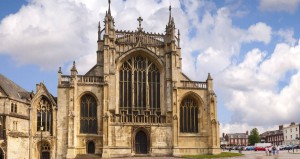
Image: travellight/Shutterstock.com
There are any number of attractions in Gloucester. From things to see and do to having fun with the kids, here are some of the best attractions in town.
Historic Sights and Landmarks
The Dean Forest Railway goes through the forest of Dean to start/stop in Gloucester. This gorgeous railway is a replicated steam train that lets you take a trip and spend the afternoon as if you were stepping back in time. Train enthusiasts, kids, and Harry Potter fans will love this.
Visit the Hopewell Colliery in the area to learn about how the miners would have dug out the coal. This museum turned mining exhibit space allows you to see how underground workings happen, as well as letting you tour some for yourself. If you’re claustrophobic this is one to avoid. The colliery is inside the Forest of Dean where you will find many attractions.
There are any number of old buildings of a grandiose nature in town, but we quite like Thornbury Castle. Unfortunately, time has turned it into a hotel. If architecture is your thing though, see St Mary’s Church, Go get your IG shots with the Cathedral, check out Kingsgate Park, or spend a day at Dyrham Park… especially at Christmas time.
Galleries and Museums
There are so many things to learn about in Gloucester. Take the Aerospace Bristol centre which is just down the road. Learn all about the aviation history of the area and feed any budding interest in piloting. If you want to stick closer to home, the National Waterways Museum will make the history of boating and canal use in the UK much clearer.
On top of both, Gloucester is home to a Jet Age museum that celebrates all things aviation. They have a large collection of jets that will satisfy any young budding pilot’s curiosity. The best part is the open cockpits outside where you can sit in and get a feel at the controls. Pretending to be Tom Cruise is optional.
Last but never least, you can see an especially awesome exhibit and maybe even pick up some artwork, at the Beatrix Potter shop and Museum. This place is inspired by the wonderful children’s writer whose stories we all grew up with.
Outdoor Attractions
The Gloucester Docks have a remarkable history to them and are the perfect place to people-watch at one of the many cafes. Do some fishing off the side with a rentable line, or try your hand to magnet fishing, if you dare. The docks and the canal walk are two of the best-rated attractions in town according to Trip Advisor.
There is a Garden Centre called Blooms in town which gets a ton of interest from older tourists. If you are taking your nan on holiday with you, stop by here for a cream tea and an argument about whether the jam or the cream goes first.
In Gloucester in summer, you are overwhelmed with possibilities. Go try your hand at running a boat in the canal, visit Robins wood Hill Country Park, take a trip over to the Forest of Dean and explore, or browse the beauty of Hill field Gardens.
Sports and Recreation
Gloucester City AFC is one of the teams that use Kingsholme Stadium. They have vast swathes of fans who regularly stop in for stadium tours and matches. The other team is the Gloucester rugby team, who play in the Gallagher Premiership alongside the cream of English Rugby Union teams
Shopping and Retail
If you don’t shop in the town centre then you head to the Quays shopping mall, which has everything you could possibly need. Beware of Saturday afternoons as it gets busy!
Things we Almost Missed
We couldn’t cover everything because Gloucester is literally teeming with possibility. Here are some of the attractions we didn’t detail, but that we still want to make time to go see.
- St Michael’s tower can be seen from all over town but there isn’t much to do there other than take pictures.
- The Museum of Gloucester details the history of the area.
- The soldiers of Gloucester Museum give you all sorts of historic options.
- There are a few breweries you can tour; we prefer the Gloucester Brewery because it’s all in the name.
- Go tenpin bowling, visit the crypt at St Mary’s, or spend an afternoon at the Antiques Centre.
Go to Gloucester, is the sum of it all. You are bound to find inspiration and have a great time. You probably won’t get everything done in one week though, so best make it two.
How to Get to Gloucester
As usual, we are at the stage where everything has been covered except the how-to-get-there part. If you want, you could use a map. If you are the adventurous type, follow our loose directions below and hope your gamble ends up as a win.
By Road
If you head either north or south on the M5 you will reach Gloucester.
By Rail
You are looking for Gloucester railway station on the Great Western line.
By Air
The nearest airport is Bristol.
By Sea
The canal in Gloucester leads straight out to the Severn Estuary, so you can get there by sea.
A Bit About Us
Here at Five Minutes Spare, we report on all the towns and cities worth visiting, throughout the UK and the rest of the world. Have a look at our local travel guides’ favourite destinations and see if you can find your own town. If you spot it, drop us a follow on Facebook or Instagram. We will try to make sure you don’t regret it

